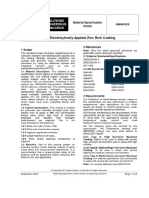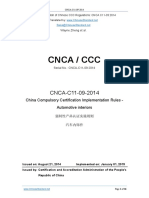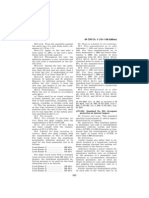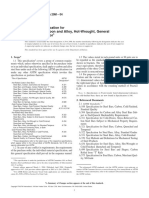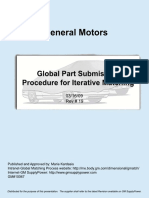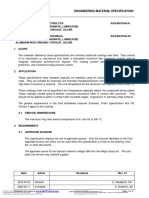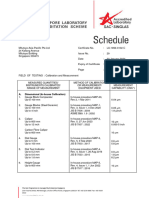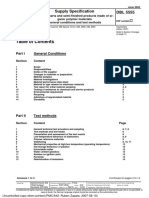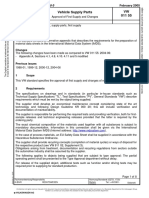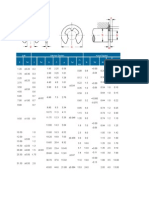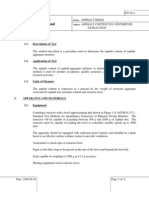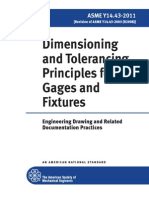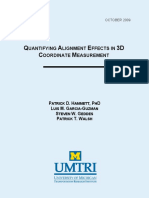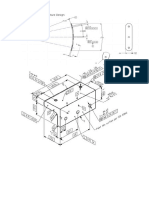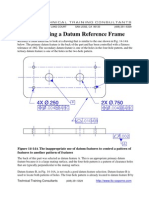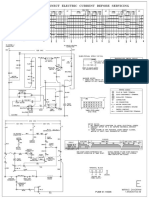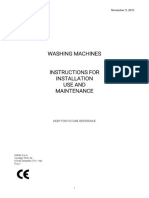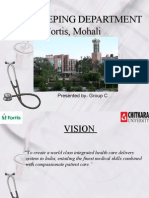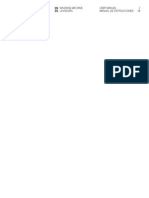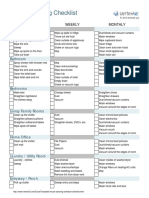GMW16037
GMW16037
Uploaded by
Anonymous 7ZTcBnCopyright:
Available Formats
GMW16037
GMW16037
Uploaded by
Anonymous 7ZTcBnCopyright
Available Formats
Share this document
Did you find this document useful?
Is this content inappropriate?
Copyright:
Available Formats
GMW16037
GMW16037
Uploaded by
Anonymous 7ZTcBnCopyright:
Available Formats
WORLDWIDE
ENGINEERING
STANDARDS
Test Procedure
Materials
GMW16037
Test Method to Quantify Cleanliness of Powertrain Components
Copyright 2009 General Motors Corporation All Rights Reserved
July 2009
Originating Department: North American Engineering Standards
Page 1 of 4
1 Scope
Note: Nothing in this standard supersedes
applicable laws and regulations.
Note: In the event of conflict between the English
and domestic language, the English language shall
take precedence.
1.1 Purpose. This document outlines a method for
determining the weight (and size, if specified) of
foreign material (residual dirt) retained in or on any
component after final washing and just prior to
engine or transmission assembly.
1.2 Foreword. This method may be used to
quantify foreign material present in components,
sub-assemblies and assemblies; and may be used
after pre-machining operations prior to shipment to
the final machining location.
1.3 Applicability. The method involves washing
engine and transmission components deemed
necessary with a specified wash fluid, collecting
the rinse wash fluid, filtering solid materials from it
and determining the weight (and size, if specified)
of solids present.
2 References
Note: Only the latest approved standards are
applicable unless otherwise specified.
2.1 External Standards/Specifications.
None
2.2 GM Standards/Specifications.
None
3 Resources
3.1 Facilities. While no specific facility
requirements are defined herein, it is preferred that
the test procedure is carried out in an enclosed
room or laboratory separate from the plant
environment. This will protect the equipment and
minimize the possibility of introducing foreign
material to the components.
3.2 Equipment. A list of equipment and materials
which may be necessary and useful in evaluating
components for sediment levels is shown in
Appendix A.
3.2.1 Nylon filter membranes, 10 micron
(maximum), shall be used except where local test
procedures require the use of 44 micron
(maximum) and 10 micron (maximum) nylon filters
in series.
3.2.2 Paper filter elements may also be used at
those locations where this procedure is used to
monitor grease content of plant wash system
coolant.
3.2.3 A 5 micron filter (or equivalent) shall be used
for filtering wash fluid that is recycled to a
reservoir.
3.2.4 Acceptable wash fluids are listed in
Appendix A.
3.3 Test Vehicle/Test Piece. Components,
subassemblies and assemblies shall be obtained
from the production process at the point of their
inclusion into the assembly (if washed at the plant)
or as shipped from a supplier (if shipped directly to
the assembly line). Components may also be
obtained from the production line at the final
washer exit in order to monitor and control washer
effectiveness.
3.4 Test Time. Not applicable.
3.5 Test Required Information. Not applicable.
3.6 Personnel/Skills. Per local requirements.
4 Procedure
4.1 Preparation. Prior to sediment evaluation, test
samples must not be rinsed, wiped, or cleaned in
any way other than what is typical for the
production process. Lot numbers or other pertinent
shipment information should be recorded for
samples to be tested. Protect samples from
airborne debris during transport to the sediment
test equipment and avoid rough handling.
4.2 Conditions.
4.2.1 Environmental Conditions.
4.2.1.1 When evaluating transmission assemblies,
torque converters shall be checked separately,
exterior surfaces shall not be rinsed as part of the
procedure. Local procedures shall dictate whether
or not to remove valves from bores.
GMW16037 GM WORLDWIDE ENGINEERING STANDARDS
Copyright 2009 General Motors Corporation All Rights Reserved
Page 2 of 4 July 2009
4.2.1.2 Test frequency and sample size should be
determined by local plant procedures. Sample size
must be sufficient to allow for statistical control of
production processes and establishment of control
limits. Reduced sampling is possible based on
statistical data showing process capability.
4.2.1.3 Reintroduction of test samples into the
production process must occur before the final
wash.
4.2.2 Test Conditions. Deviations from the
requirements of this standard shall have been
agreed upon. Such requirements shall be specified
on component drawings, test certificates, reports,
etc.
4.3 Instructions.
4.3.1 Prepare Test Equipment and Materials.
4.3.1.1 Oven dry the required number of filters for
30 to 35 minutes at 50 to 55C. Allow filters to cool
for 15 to 20 minutes in a desiccator prior to use.
Times and temperatures may be adjusted to meet
current plant practices and production schedules.
4.3.1.2 Ascertain the weight of filters to four
decimal places by means of an analytical balance
and record the value in milligrams (mg).
4.3.1.3 Rinse collection sink/tray before and after
each test with a sufficient quantity of wash fluid to
purge the system of any foreign material. Collect
the fluid in a beaker and visually examine the
sediment for unusual particles or amounts.
Equipment and materials should be protected from
environmental contamination when not in use.
4.3.1.4 Monthly wash fluid cleanliness check (for
sites that recycle fluid). Collect at least 1 L of wash
fluid in a clean beaker and note the volume used.
Filter the fluid with vacuum assist through a
pre-dried and pre-weighed 10 micron (maximum)
filter. Remove filter from the funnel and expose to
drying cycle (4.3.5.1). Determine amount of
residue collected by subtracting original filter
weight from weight of filter plus (+) residue. If
amount of residue exceeds 0.50 mg/L, wash fluid
must be replaced with new. Wash fluid must be
replaced annually regardless of test results.
4.3.2 Measurement of Test Sample. Prepare the
required number of filters per 4.3.1.1 and 4.3.1.2.
4.3.2.1 Place component to be evaluated in the
clean collection tray/washing cabinet and rinse
surfaces of interest with wash fluid. Rinse device
should be a handheld spray gun with 70 kPa
(0.7 bar) minimum nozzle pressure. Appendix A
lists equipment part numbers currently in use at
some plants. Other equipment may be acceptable
as long as a nozzle pressure of 70 kPa (0.7 bar) is
maintained throughout the rinsing operation. Effort
should be made to ensure that all foreign material
and loose debris is removed from the component
and the collection tray/washing cabinet by flushing
the tray with excess fluid and wiping it with a
non-metallic squeegee. Collect all sediment from
the tray in a beaker and mark the beaker for
identification.
4.3.2.2 Engine components with internal oil and/or
coolant passages (i.e., engine blocks) shall be
rinsed according to work instructions such that
sediment levels are established for each type of
passage. Water passages must be rinsed first.
4.3.2.2.1 To ensure all sediment is removed from
internal passageways of components such as
cylinder blocks and heads, pressurized air shall be
used. Pressure shall be 210 kPa (2.1 bar) and
orifice size shall be 2.0 mm (0.080 in).
4.3.2.3 Burrs resulting from machining operations,
casting processes, etc., which remain firmly
attached after rinsing and air blowout shall be
noted but shall not be included in the total
sediment weight. Appropriate equipment (mirrors,
lights, bore scopes) shall be used to inspect
internal passageways for loose chips not removed
by the rinse or air blowout. In such cases, proper
actions shall be taken to improve the cleanliness
process.
4.3.2.4 Any plant specific procedures regarding
rinsing sequence, burr reporting, etc., must be the
same site-to-site for similar components.
4.3.3 Place dried and weighed filters in the filtration
funnel.
4.3.4 Pour the collected wash fluid through the
filter plus (+) funnel using a vacuum assist. Rinse
the collection chamber/beaker thoroughly and
transfer the wash fluid to the funnel for filtering.
4.3.5 Carefully remove the filter from funnel and
expose to the following drying cycle.
4.3.5.1 Filters must be dried 30 to 35 minutes at 50
to 55 C. Times and temperatures may be adjusted
to meet current plant practices and production
schedules as long as there is evidence that filter
weight has stabilized for that cycle.
4.3.6 After drying, the filters shall be placed in a
desiccator to cool for 15 to 20 minutes. Debris
samples must be properly identified.
4.3.7 Weigh dried filter plus (+) sediment and
record weight.
4.3.8 Return washed parts to departments from
which they were taken unless surface condition
has been degraded or component has been
disassembled during sediment testing.
Transmission seals and clutch plates must be
scrapped.
GM WORLDWIDE ENGINEERING STANDARDS GMW16037
Copyright 2009 General Motors Corporation All Rights Reserved
July 2009 Page 3 of 4
5 Data
5.1 Calculations. Determine total sediment weight
by subtracting filter weight (4.3.1.2) from weight of
filter plus (+) sediment (4.3.7). When two filters are
used (3.2.1), weights should be reported for each
filter size.
5.2 Interpretation of Results. If something
unusual is observed on the contaminated filters
(high weights, large particles, etc.), examination of
the filters under a light microscope is
recommended. Should part specifications include a
maximum allowable particle size, measure the
sediment particles using a calibrated grid. Note the
size (longest dimension in microns) of the largest
particle and record on datasheet.
5.3 Test Documentation.
5.3.1 Transfer engine data to Statistical Process
Control (SPC) charts and plot the data, where
applicable. Transmission data should be recorded
on suitable quality charts.
5.3.2 Notify Production Department Supervisor of
any out-of-control points or otherwise undesirable
conditions.
6 Safety
This standard may involve hazardous materials,
operations, and equipment. This standard does not
propose to address all the safety problems
associated with its use. It is the responsibility of the
user of this standard to establish appropriate safety
and health practices and determine the
applicability of regulatory limitations prior to use.
7 Notes
7.1 Glossary. Not applicable.
7.2 Acronyms, Abbreviations, and Symbols.
SPC Statistical Process Control
8 Coding System
This standard shall be referenced in other
documents, drawings, etc., as follows:
Test to GMW16037
9 Release and Revisions
9.1 Release. This standard originated in August
2008, replacing GMN6752. It was first approved by
GM Powertrain in June 2009. It was first published
in July 2009.
GMW16037 GM WORLDWIDE ENGINEERING STANDARDS
Copyright 2009 General Motors Corporation All Rights Reserved
Page 4 of 4 July 2009
Appendix A
A1 Laboratory Equipment
Some specific equipment that has proven useful in
testing is listed below. Other fluids and other
brands/models of equipment may be used as long
as the test procedure is not compromised.
A1.1 Drying oven with thermometer.
A1.2 Desiccator.
A1.3 Magnet.
A1.4 Analytical balance.
A1.5 Brushes.
A1.6 Vacuum pump, manifold, and trap.
A1.7 Squeegee.
A1.8 Drum pump.
A1.9 Stainless rinse collection sink (washable,
drainable).
A1.10 Side-arm flask, filter funnel, beakers, wash
bottles.
A1.11 Sediment wash cart.
A1.12 Air line and hose.
A1.13 Nalgene vacuum manifold Catalog No.
345-0001.
A1.14 Jabsco drum pump Model #16520-3350
(to be used with air pressure of 3500 kPa (50 psi)).
A1.15 Spraying Systems Co. GunJet Model #31-
39430 (source: Industrial Hose and Hydraulics,
Ltd., 905-688-1243).
A1.16 Vacuum pump Gast 0211 Series, oiless
(pump to be set at 381 mm (15 in) of Hg); or Piab,
Inc.
A1.17 Wash Fluids TechSolv 331 or 336;
Chemcentral SC142; Betz Permatreat 435 (4%
solution); Citrikleen 3SR166 (1:10 in water);
Odorless mineral spirits (Trans only); Naptha.
A1.18 Nylon filter membranes Great Lakes
Filters Part Number(as) 325-041-8000 (engines)
and
321-041-8000 (transmissions). Phone No.1-800-
521-8565.
A1.19 Stereomicroscope.
A2 Transmission Solvent Handling
System
A2.1 Sanborn paint tank and sprayer (#011-0798
(pressurized container).
A2.2 Whatman Gamma - 12 high performance
inline filter unit.
A2.3 Whatman filter tube 12-10 (VWR #28205-
349).
A2.4 Whatman filter tube 12-80 (VWR #28205-
280).
A2.5 Millipore 25 mm Filter-Jet solvent dispenser.
A3 Transmission Vacuum Filtration
System
A3.1 Kewaunee Scientific 1.22 m (4 ft) airflow
supreme hood.
A3.2 Gelman Sciences parabolic filter 4230.
A3.3 Funnel with Essig fitting.
A3.4 Gelman Sciences support screen 4235,
Serial No. 14770-00.
A3.5 Bottle, 18.9 L (5 gal).
A3.6 Hazardous waste collection drum.
You might also like
- Beko WTL84111B Wtl84151b, Wtl84141w, Wtl84111w, Wtl84151w, Wtl84131w, Wtl84141. User ManualDocument32 pagesBeko WTL84111B Wtl84151b, Wtl84141w, Wtl84111w, Wtl84151w, Wtl84131w, Wtl84141. User Manualnadaljoachim77No ratings yet
- GMW 3359Document5 pagesGMW 3359Anonymous 7ZTcBnNo ratings yet
- Sample Marketing PlanDocument35 pagesSample Marketing Plangeng bongolanNo ratings yet
- GORE Automotive Vents Exterior Lighting Datasheet ENDocument4 pagesGORE Automotive Vents Exterior Lighting Datasheet ENAaron HuangNo ratings yet
- Part Labeling SpecificationDocument9 pagesPart Labeling SpecificationJosué PérezNo ratings yet
- Fmvss 302Document7 pagesFmvss 302PRABHJOT SINGH100% (1)
- Ford Esbc3p-7w092-BaDocument45 pagesFord Esbc3p-7w092-Bamiguel angelNo ratings yet
- AS10169Document11 pagesAS10169JOECOOL67No ratings yet
- DBL 5404 - 2014Document38 pagesDBL 5404 - 2014Mateo BanzanNo ratings yet
- Insulating Material PV 3357: KonzernnormDocument7 pagesInsulating Material PV 3357: Konzernnormerik0007No ratings yet
- Cnca C11-09-2014Document12 pagesCnca C11-09-2014raybchNo ratings yet
- FMVSS 201Document22 pagesFMVSS 201Dilpreet99100% (1)
- Astm A29 PDFDocument17 pagesAstm A29 PDFAnonymous 7ZTcBn67% (3)
- STJLR-99-9999 - Iss 2Document17 pagesSTJLR-99-9999 - Iss 2Seda De DrasniaNo ratings yet
- Rubber TestingDocument4 pagesRubber TestingSharma ShailenNo ratings yet
- Fmvss 209 Seat Belts Tp-209-08Document76 pagesFmvss 209 Seat Belts Tp-209-08RTCNNo ratings yet
- Embrittlement Avoidance WSS-M99A3-A 1. Scope: Engineering Material SpecificationDocument5 pagesEmbrittlement Avoidance WSS-M99A3-A 1. Scope: Engineering Material SpecificationGustavo FelipeNo ratings yet
- GS1 DataMatrix Guideline0115Document62 pagesGS1 DataMatrix Guideline0115Riadh JellaliNo ratings yet
- GM 10067Document43 pagesGM 10067francisco100% (1)
- Sae J1960-2008Document2 pagesSae J1960-2008NameNo ratings yet
- Elastomers - Material Requirements and TestingDocument17 pagesElastomers - Material Requirements and TestingPravin Balasaheb Gunjal100% (1)
- STJLR 01 5070Document4 pagesSTJLR 01 5070manuanil1989No ratings yet
- Fca Us LLC: IMDS Reporting GuideDocument19 pagesFca Us LLC: IMDS Reporting GuidePerola CaponelliNo ratings yet
- WSS-M21P40 22-03-2019Document6 pagesWSS-M21P40 22-03-2019Ronald AraujoNo ratings yet
- Jupiter T-Bolt ClampsDocument2 pagesJupiter T-Bolt ClampsSandeepraje Nalawade PatilNo ratings yet
- TL 52038 enDocument12 pagesTL 52038 enCindy Rivera100% (1)
- Nat'l Highway Traffic Safety Admin., DOT 571.302: 571.302 Standard No. 302 Flamma-Bility of Interior MaterialsDocument3 pagesNat'l Highway Traffic Safety Admin., DOT 571.302: 571.302 Standard No. 302 Flamma-Bility of Interior MaterialsChloe ReyesNo ratings yet
- Scratch Resistance Test BSENISO15182001Document14 pagesScratch Resistance Test BSENISO15182001Jose Antonio Lucero CruzNo ratings yet
- Kardan Mili Mafsal İstavrozlari (Universal Joint Kits) : KOD DIA. Mm. Referans No Oem No Koli FiyatDocument115 pagesKardan Mili Mafsal İstavrozlari (Universal Joint Kits) : KOD DIA. Mm. Referans No Oem No Koli FiyatЕвгенийNo ratings yet
- As 2282.8-1999 Methods For Testing Flexible Cellular Polyurethane Determination of Force DeflectionDocument2 pagesAs 2282.8-1999 Methods For Testing Flexible Cellular Polyurethane Determination of Force DeflectionSAI Global - APACNo ratings yet
- 2019 Toyota Camry ANCAP ReportDocument3 pages2019 Toyota Camry ANCAP ReportcarbasemyNo ratings yet
- Powder Coat Performance Spec WSS M70J5 C1Document9 pagesPowder Coat Performance Spec WSS M70J5 C1Michal BílekNo ratings yet
- ASME B46.1-2009 Surface Texture (Surface Roughness, Waviness, and Lay) - Part2Document37 pagesASME B46.1-2009 Surface Texture (Surface Roughness, Waviness, and Lay) - Part2R JNo ratings yet
- Ps 9227Document5 pagesPs 9227ibrahime mohammedNo ratings yet
- Plating SpecsDocument10 pagesPlating Specscamex.eng05100% (1)
- Brake Roughness - Disc Brake Torque Variation, Rotor Distortion and Vehicle ResponseDocument15 pagesBrake Roughness - Disc Brake Torque Variation, Rotor Distortion and Vehicle Responsedebisi14140100% (1)
- Chrysler Customer-Specific Requirements JAN 2013Document41 pagesChrysler Customer-Specific Requirements JAN 2013timkoid100% (1)
- Gap Flush - Filled ReportDocument7 pagesGap Flush - Filled ReportajayNo ratings yet
- MS 90075Document11 pagesMS 90075erik0007No ratings yet
- Cs 9003Document22 pagesCs 9003ibrahime mohammed100% (1)
- Cellasto A Microcellular Polyurethane ElastomerDocument12 pagesCellasto A Microcellular Polyurethane ElastomerHari SuthanNo ratings yet
- Mitutoyo Singapur ScopeDocument5 pagesMitutoyo Singapur ScopeADROIT ROHMATTULLOH100% (1)
- Supply Specification DBL 5555: General ConditionsDocument17 pagesSupply Specification DBL 5555: General ConditionsMateo BanzanNo ratings yet
- En-PpDocument34 pagesEn-PpDan IlcaNo ratings yet
- ISO 3302-1:1996 (E) : M-ClassDocument2 pagesISO 3302-1:1996 (E) : M-ClassMarcos Antonio RossiNo ratings yet
- VW01155 en 2005-02-01Document8 pagesVW01155 en 2005-02-01koalaboi0% (1)
- TMS6900Document14 pagesTMS6900Josue Garcia QuiniNo ratings yet
- Chrysler StandardDocument25 pagesChrysler Standardabraham_ginNo ratings yet
- JDN 179Document11 pagesJDN 179X800XLNo ratings yet
- Threads - Pre-Plate Vs Post Plate Class-MetricDocument3 pagesThreads - Pre-Plate Vs Post Plate Class-MetricNaveen MaliNo ratings yet
- Quality Assurance of Pressure-Sensitive Tapes: Standard Practice ForDocument6 pagesQuality Assurance of Pressure-Sensitive Tapes: Standard Practice ForYoga PradanaNo ratings yet
- MIL Aa 58092Document6 pagesMIL Aa 58092sanjay_aranakeNo ratings yet
- 2020 - 11 - 01 - GMW 14892Document14 pages2020 - 11 - 01 - GMW 14892jose luisNo ratings yet
- QB 11920999Document41 pagesQB 11920999matej princesNo ratings yet
- ISO 3547-2-2006 Plain Bearings - Test Data For Outside and Inside DiametersDocument18 pagesISO 3547-2-2006 Plain Bearings - Test Data For Outside and Inside DiametersDU100% (1)
- GMW3220 Aug 2016Document4 pagesGMW3220 Aug 2016Elena Ruiz100% (1)
- Din 6799Document1 pageDin 6799orkunugurNo ratings yet
- Standard Test Procedures Manual: 1. Scope 1.1. Description of TestDocument7 pagesStandard Test Procedures Manual: 1. Scope 1.1. Description of Testengineermik7956No ratings yet
- Talc OSHA 2121Document15 pagesTalc OSHA 2121Zenal AbidinNo ratings yet
- GMW 14872 PDFDocument21 pagesGMW 14872 PDFJetesh Devgun100% (2)
- Manual - Filter Oil Test Rig - ISO 1 & 3Document5 pagesManual - Filter Oil Test Rig - ISO 1 & 3Rudra QMS SolutionNo ratings yet
- Plate and Frame Filter PressDocument16 pagesPlate and Frame Filter Pressraneshkumar19920% (1)
- Section 02750 Sewage Treatment Plant Performance SpecificationDocument18 pagesSection 02750 Sewage Treatment Plant Performance SpecificationOlivas L. Baguec JrNo ratings yet
- Cleanroom Technology: Fundamentals of Design, Testing and OperationFrom EverandCleanroom Technology: Fundamentals of Design, Testing and OperationRating: 5 out of 5 stars5/5 (1)
- Aluminium AlloysDocument12 pagesAluminium AlloysAnonymous 7ZTcBn100% (2)
- Profile Tolerance Iso1101 2012Document5 pagesProfile Tolerance Iso1101 2012Anonymous 7ZTcBnNo ratings yet
- Johnson Controls Automotive Experience Global Supplier Standards Manual Tooling and Equipment Metal Stamping Dies - Gage Standards December, 2012Document31 pagesJohnson Controls Automotive Experience Global Supplier Standards Manual Tooling and Equipment Metal Stamping Dies - Gage Standards December, 2012Anonymous 7ZTcBnNo ratings yet
- Dimensioning and Tolerancing Principles For Gages and FixturesDocument5 pagesDimensioning and Tolerancing Principles For Gages and FixturesKarthik Karunanidhi0% (2)
- 000 Uncertainty of Axi Symmetric Measurement MachineDocument8 pages000 Uncertainty of Axi Symmetric Measurement MachineAnonymous 7ZTcBnNo ratings yet
- BS en 10002 1 1990Document31 pagesBS en 10002 1 1990Anonymous 7ZTcBnNo ratings yet
- Apply Datum Shift in CMM Software HTTPDocument3 pagesApply Datum Shift in CMM Software HTTPAnonymous 7ZTcBnNo ratings yet
- BS en 10002 1 1990Document31 pagesBS en 10002 1 1990Anonymous 7ZTcBnNo ratings yet
- Basic GD&T - Datums PDFDocument35 pagesBasic GD&T - Datums PDFtnchsgNo ratings yet
- Effect of Sodium Modification On Microstructure and Mechanical Properties of Thick-Walled Alsi6Cu2.5 Rheocast ComponentDocument6 pagesEffect of Sodium Modification On Microstructure and Mechanical Properties of Thick-Walled Alsi6Cu2.5 Rheocast ComponentAnonymous 7ZTcBnNo ratings yet
- PV 3347 Englisch CleanlinessDocument12 pagesPV 3347 Englisch CleanlinessAnonymous 7ZTcBn100% (1)
- ISO 13715 Sizes of EdgesDocument19 pagesISO 13715 Sizes of EdgesAnonymous 7ZTcBn75% (4)
- Flat/Planar Datums - Establishing Datums - Datum Reference Frame (DRF) - 3, 2, 1 RuleDocument13 pagesFlat/Planar Datums - Establishing Datums - Datum Reference Frame (DRF) - 3, 2, 1 RuleAnonymous 7ZTcBnNo ratings yet
- Alignment UMTRI 2009 Oct301Document43 pagesAlignment UMTRI 2009 Oct301Anonymous 7ZTcBnNo ratings yet
- N33 9 4 2015-04-15Document7 pagesN33 9 4 2015-04-15Anonymous 7ZTcBnNo ratings yet
- Functional Gage and Fixture DesignDocument8 pagesFunctional Gage and Fixture DesignAnonymous 7ZTcBn0% (1)
- Controlling The Geometry of SlotsDocument35 pagesControlling The Geometry of SlotsAnonymous 7ZTcBnNo ratings yet
- Sae j468-1988 Zinc Alloy Ingot and Die Casting CompositionsDocument3 pagesSae j468-1988 Zinc Alloy Ingot and Die Casting CompositionsAnonymous 7ZTcBn100% (1)
- Fdu 01Document8 pagesFdu 01Anonymous 7ZTcBnNo ratings yet
- Datum Features of Size With ModifierDocument2 pagesDatum Features of Size With ModifierAnonymous 7ZTcBnNo ratings yet
- Estab A Datum Ref Frame3Document3 pagesEstab A Datum Ref Frame3Anonymous 7ZTcBnNo ratings yet
- B1.3 AssignmentDocument2 pagesB1.3 Assignmentphúc Trần VĩnhNo ratings yet
- Imo Screw Pumps ACG-UCG 7Document12 pagesImo Screw Pumps ACG-UCG 7Chhoan NhunNo ratings yet
- Diagrama Electrico Mrocha Frigidaire E 134806700 BDocument3 pagesDiagrama Electrico Mrocha Frigidaire E 134806700 BJavier Leon100% (1)
- Chorus Trio: Service MenuDocument151 pagesChorus Trio: Service MenuАлексей ЖижченкоNo ratings yet
- Installation - Manual GirbauDocument44 pagesInstallation - Manual GirbauTan Hung LuuNo ratings yet
- Soring User Manual Macro Handpiece PDFDocument9 pagesSoring User Manual Macro Handpiece PDFDanilo FagundesNo ratings yet
- Safety Instructions: Energy StarDocument80 pagesSafety Instructions: Energy StarTerrence JonesNo ratings yet
- Manual E190601X - ENGDocument36 pagesManual E190601X - ENGMinh Hiếu TrầnNo ratings yet
- Wae 22462 AuDocument8 pagesWae 22462 AuDaniel ManoleNo ratings yet
- Poultry House DisinfectionDocument121 pagesPoultry House Disinfectionthanh ba matNo ratings yet
- Cleaning of Equipment & AreaDocument33 pagesCleaning of Equipment & AreaYgdhj YfdsNo ratings yet
- Stolle Optimus Can Washer: ConnectingDocument2 pagesStolle Optimus Can Washer: ConnectingLópez LuisNo ratings yet
- Information On Brine PeelingDocument4 pagesInformation On Brine PeelingIzyan Mohd SubriNo ratings yet
- Stay Positive and Enjoy The Journey: News From Motibhai GroupDocument4 pagesStay Positive and Enjoy The Journey: News From Motibhai GroupMotibhai GroupNo ratings yet
- 3 Year ProjectDocument189 pages3 Year ProjectBebe GranjaNo ratings yet
- House KeepingDocument22 pagesHouse KeepingDrSwaty Sharma100% (1)
- Milnor 48040F7J & F7ZDocument42 pagesMilnor 48040F7J & F7Zldcmaint123No ratings yet
- Aeg L75280FLDocument72 pagesAeg L75280FLmaestro5244No ratings yet
- Indesit PDFDocument72 pagesIndesit PDFPetreanu IulianNo ratings yet
- House-Cleaning-Checklist - Lista de Tarefas DomesticasDocument1 pageHouse-Cleaning-Checklist - Lista de Tarefas DomesticasloureirooliveiraNo ratings yet
- Service Manual: Auto WasherDocument38 pagesService Manual: Auto WasherCarlos RuizNo ratings yet
- Washing Equipment Product Handbook - WEB - 06 2016Document52 pagesWashing Equipment Product Handbook - WEB - 06 2016Lmf DanielNo ratings yet
- Fluido 2 ManualDocument68 pagesFluido 2 ManualEdmar MirandaNo ratings yet
- Unsafe Acts 2023Document16 pagesUnsafe Acts 2023arsh124No ratings yet
- FWM-600W Instruction Manual PDFDocument16 pagesFWM-600W Instruction Manual PDFSutharsanJIslesNo ratings yet
- 01 PJ Commercial and Industrial Cold Water Electric.2Document40 pages01 PJ Commercial and Industrial Cold Water Electric.2Santiago AlbarranNo ratings yet
- Spesifikasi Uniclean PL II 15Document1 pageSpesifikasi Uniclean PL II 15Chaerul FadillahNo ratings yet
- Whirlpool Cabrio Bearing Replacement Kit W10435302 Instructions and VideoDocument9 pagesWhirlpool Cabrio Bearing Replacement Kit W10435302 Instructions and VideometroroadNo ratings yet

